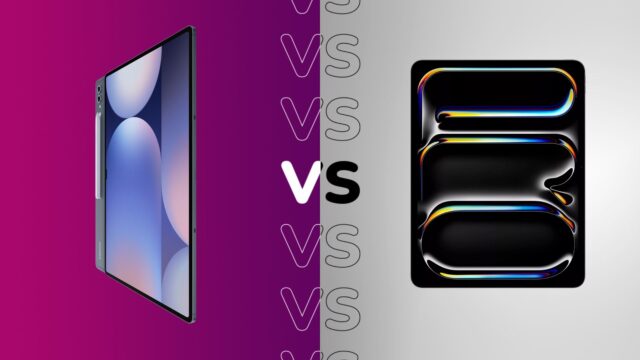Samsung’s new Galaxy Tab S10 Ultra looks to offer an ultra-premium Android tablet experience, but how does it compare to Apple’s top-end iPad Pro (2024)?
The Samsung Galaxy Tab S10 Ultra has the iPad Pro beaten in terms of sheer screen size, measuring in at 14.6 inches compared to the 11- and 13-inch screens from Apple. However, Apple has the upper hand in the screen tech department with advanced Tandem OLED tech compared to Samsung’s standard Dynamic AMOLED 2X screen tech.
The iPad Pro is also thinner and lighter than the Galaxy Tab S10 Ultra – the 13-inch model, anyway – and it’s more powerful with its desktop-class M4 chipset.
That said, there are plenty of similarities between the two tablets; both offer advanced generative AI-powered features, and each boasts support for high-end accessories that further expand functionality.
We’ve spent plenty of time with the iPad Pro (2024), and we’ve gone hands-on with the Samsung Galaxy Tab S10 Ultra, so here’s an early look at how the two compare.
Pricing & availability
Both the iPad Pro and Samsung Galaxy Tab S10 Ultra are high-end tablets and feature high-end price tags to match.
The iPad Pro is available in 11- and 13-inch variants, with the 11-inch models starting at £999, while the 13-inch model comes in at £1,299. That’s with 256GB storage, though you can get up to 2TB.
The Samsung Galaxy Tab S10 Ultra, on the other hand, starts at £1,199/$1,199 with 256GB of storage, though unlike the iPad Pro, it caps out at 1TB of storage. It’s available to pre-order now ahead of release on 4 October 2024.
The iPad Pro (2024) is thinner and lighter
Samsung’s Galaxy Tab S10 Ultra shouldn’t be considered a thick tablet, measuring in at a svelte 5.4mm thick that’s 0.1mm thinner than its predecessor, but it can’t quite compete with Apple’s iPad Pro 13.
That’s because the iPad Pro 13 is the thinnest product that Apple has ever made, measuring in at an impossibly thin 5.1mm, and it’s also quite a bit lighter than the Galaxy Tab S10 Ultra at just 759g compared to 718g.

That doesn’t necessarily mean that the iPad Pro can be described as portable, especially the 13-inch variant, but it should be a little easier to handle than the Galaxy Tab S10 Ultra.
There is a benefit to going with the slightly thicker Galaxy Tab S10 Ultra though; it has IP68 dust and water resistance, something Apple’s top-end tablet doesn’t offer in any form. It also features an upgraded Enhanced Armor Aluminium frame which the company claims is 10% harder and, thus, more resistant to scratches and dings compared to its predecessor.
The Samsung Galaxy Tab S10 Ultra has a larger screen
The Samsung Galaxy Tab S10 Ultra has one of the biggest screens you’ll find on any tablet, measuring in at a whopping 14.6 inches.
It’s a high-end screen too; the Dynamic AMOLED 2X screen tech offers an LTPO-enabled 120Hz refresh rate, support for HDR10+ and it sports the same anti-reflective coating as the Galaxy S24 range for improved viewability in bright environments.


The iPad Pro, on the other hand, is available in two screen sizes; 11 inches and 13 inches. Regardless of the screen size you go for, you’ll be getting the same high-end experience with Tandem OLED tech.
Exclusive to the iPad Pro range, it’s essentially a double-stacked OLED panel that helps boost brightness far beyond what you’d expect from a large OLED panel at 1600nits. Samsung has yet to mention just how bright the Tab S10 Ultra can get, but we suspect it might not be quite as high.
You’ll also get a 120Hz LTPO-enabled refresh rate for buttery-smooth scrolling, along with support for Dolby Vision, HDR10 and more.
The iPad Pro (2024) is more powerful
One of the main reasons to opt for the iPad Pro (2024) over any other iPad, or frankly any other tablet on the market, is the chipset at its heart. In place of the A-series chipsets used in much of the iPad range, the iPad Pro range sports Apple’s latest desktop-class chipset, the Apple M4.
In fact, it got the M4 treatment before any other Apple product, with the likes of the MacBook Pro and iMac yet to get the boosted processor.
Regardless, this is a blisteringly fast processor that delivered benchmark scores leagues above the competition, including a score of 14,555 in the Geekbench 6 multi-core test, and it allows the iPad Pro to handle practically anything you could throw at it – including AAA games like Resident Evil Village.


That’s not to say that the Samsung Galaxy Tab S10 Ultra is a slow tablet by any means, sporting MediaTek’s top-end Dimensity 9300+ chipset along with either 12- or 16GB of RAM depending on the storage option you go for.
It’s among the most powerful chipsets on the Android market, and it has scored an impressive multi-core score of 7092 in Geekbench 6 in our early tests, but it’s still leagues behind Apple’s M4 chipset.
Both have AI smarts
Both Apple and Samsung are offering their spins on generative AI features on their tablets in the form of Apple Intelligence and Galaxy AI.
Apple Intelligence looks to be the more holistic of the two systems, offering a smarter Siri, image editing tools, notification summaries, call summaries, writing tools and even integration for third-party LLMs like ChatGPT to further expand what the tablet can do.
Galaxy AI, on the other hand, is focused more on creation and productivity, with its competing writing tools, the ability to summarise web pages and audio recordings, edit images with a sketch using GenAI and generate portraits of yourself in different AI styles.
There’s a catch however; while Galaxy AI is available in most regions, Apple Intelligence is currently in the public beta test phase ahead of a wider rollout in the US in October, with the likes of the UK getting access months later in December 2024.
Both have a swathe of high-end accessories
Whether you go for Apple or Samsung’s high-end tablet, you’ll have access to some equally premium accessories.
The latest generation of iPad Pro plays nicely with Apple’s redesigned Magic Keyboard, sporting a larger glass trackpad, new function keys and more, as well as the new Apple Pencil Pro. It’s much like previous Apple styluses, though it also offers squeeze support to change tools, and it can also detect rotation thanks to a new gyroscope.
The catch is that these are very expensive accessories, with the Magic Keyboard coming in at either £299/$299 or £349/$349 depending on the size of iPad Pro you use, and the Apple Pencil Pro comes in at £129/$129.


The Samsung Galaxy Tab S10 Ultra has a similar range of accessories including the Samsung Keyboard Cover that, like the Magic Keyboard, turns the Galaxy Tab S10 Ultra into something resembling a laptop, complete with trackpad. It goes a step further with its DeX desktop mode, however, offering something like the Windows 11 interface complete with all your tablet’s apps.
Then there’s the S Pen. It’s not quite as capable as the Apple Pencil Pro, lacking that snazzy rotation-detection technology, but it offers a lower-latency experience at just 2.8ms compared to Apple’s 9ms which should provide a more natural, responsive writing and drawing experience.
Crucially, while the Keyboard Cover remains a premium accessory at £199/$199, the S Pen comes bundled with the Galaxy Tab S10 Ultra at no additional cost.
Early Thoughts
While we’ll save our final thoughts for when we’ve fully tested and benchmarked the Samsung Galaxy Tab S10 Ultra, it’s clear that both tablets are capable in their own regard.
Samsung has a huge screen, Windows-esque support in the form of DeX when paired with a Keyboard Cover, and it comes with an S-Pen bundled in the box despite being cheaper than the competing iPad Pro.
The iPad Pro range, on the other hand, boasts more advanced Tandem OLED tech for impressive everyday performance, and it’s easily the more powerful of the two thanks to the desktop-class M4 chipset. It also has a range of accessories, though you’ll have to pay for these separately, and they’re just as premium as the tablet is.










